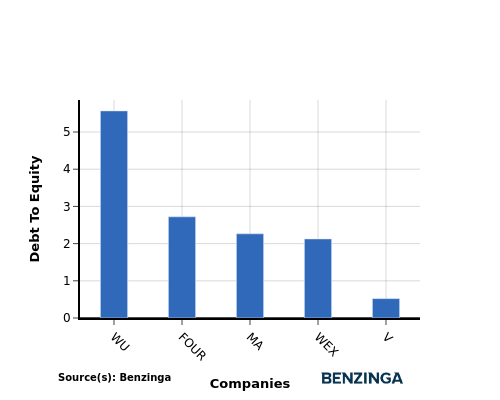In today’s rapidly evolving and fiercely competitive business landscape, it is crucial for investors and industry analysts to conduct comprehensive company evaluations. In this article, we will undertake an in-depth industry comparison, assessing Visa (NYSE:V) alongside its primary competitors in the Financial Services industry. By meticulously examining crucial financial indicators, market positioning, and growth potential, we aim to provide valuable insights to investors and shed light on company’s performance within the industry.
Visa Background
Visa is the largest payment processor in the world. In fiscal 2022, it processed over $14 trillion in total volume. Visa operates in over 200 countries and processes transactions in over 160 currencies. Its systems are capable of processing over 65,000 transactions per second.
| Company | P/E | P/B | P/S | ROE | EBITDA (in billions) | Gross Profit (in billions) | Revenue Growth |
|---|---|---|---|---|---|---|---|
| Visa Inc | 32.06 | 14.19 | 17.28 | 12.46% | $6.48 | $6.97 | 8.8% |
| Mastercard Inc | 40.44 | 64.41 | 18.03 | 42.16% | $3.67 | $5.02 | 12.57% |
| Fiserv Inc | 31.84 | 3.14 | 5.12 | 2.93% | $2.16 | $3.08 | 6.18% |
| PayPal Holdings Inc | 16.93 | 3.31 | 2.42 | 6.87% | $2.14 | $3.67 | 8.71% |
| Block Inc | 4073 | 2.68 | 2.28 | 0.98% | $0.15 | $2.03 | 24.13% |
| Fidelity National Information Services Inc | 85.59 | 2.20 | 4.38 | 1.3% | $0.66 | $0.97 | -0.59% |
| Global Payments Inc | 34.52 | 1.44 | 3.53 | 1.59% | $0.99 | $1.51 | 8.03% |
| Corpay Inc | 23.17 | 6.70 | 6.06 | 8.07% | $0.51 | $0.74 | 6.08% |
| Jack Henry & Associates Inc | 33.36 | 7.20 | 5.76 | 5.43% | $0.17 | $0.22 | 7.99% |
| WEX Inc | 38.52 | 5.44 | 4.03 | 4.83% | $0.27 | $0.41 | 7.21% |
| StoneCo Ltd | 26.08 | 1.79 | 2.36 | 2.94% | $0.9 | $2.18 | 25.35% |
| Euronet Worldwide Inc | 19.75 | 3.98 | 1.52 | 5.79% | $0.15 | $0.36 | 10.63% |
| The Western Union Co | 8.18 | 9.82 | 1.17 | 23.25% | $0.22 | $0.4 | -3.63% |
| PagSeguro Digital Ltd | 13.72 | 1.74 | 2.51 | 3.74% | $1.79 | $0.2 | 7.56% |
| DLocal Ltd | 31.80 | 9.89 | 7.26 | 6.44% | $-0.02 | $0.07 | 58.75% |
| Shift4 Payments Inc | 45.35 | 6.19 | 1.54 | 2.6% | $0.09 | $0.2 | 31.19% |
| Paymentus Holdings Inc | 122.72 | 6.37 | 4.50 | 2.22% | $0.02 | $0.05 | 24.68% |
| Evertec Inc | 32.09 | 4.28 | 3.68 | 2.04% | $0.06 | $0.1 | 20.29% |
| Payoneer Global Inc | 20.33 | 2.71 | 2.31 | 4.15% | $0.03 | $0.19 | 22.21% |
| Average | 260.97 | 7.96 | 4.36 | 7.07% | $0.78 | $1.19 | 15.41% |
table {
width: 100%;
border-collapse: collapse;
font-family: Arial, sans-serif;
font-size: 14px;
}
th, td {
padding: 8px;
text-align: left;
}
th {
background-color: #293a5a;
color: #fff;
text-align: left;
}
tr:nth-child(even) {
background-color: #f2f4f8;
}
tr:hover {
background-color: #e1e4ea;
}
td:nth-child(3), td:nth-child(5) {
text-align: left;
}
.dividend-amount {
font-weight: bold;
color: #0d6efd;
}
.dividend-frequency {
font-size: 12px;
color: #6c757d;
}
Upon a comprehensive analysis of Visa, the following trends can be discerned:
-
The stock’s Price to Earnings ratio of 32.06 is lower than the industry average by 0.12x, suggesting potential value in the eyes of market participants.
-
With a Price to Book ratio of 14.19, which is 1.78x the industry average, Visa might be considered overvalued in terms of its book value, as it is trading at a higher multiple compared to its industry peers.
-
With a relatively high Price to Sales ratio of 17.28, which is 3.96x the industry average, the stock might be considered overvalued based on sales performance.
-
The company has a higher Return on Equity (ROE) of 12.46%, which is 5.39% above the industry average. This suggests efficient use of equity to generate profits and demonstrates profitability and growth potential.
-
Compared to its industry, the company has higher Earnings Before Interest, Taxes, Depreciation, and Amortization (EBITDA) of $6.48 Billion, which is 8.31x above the industry average, indicating stronger profitability and robust cash flow generation.
-
Compared to its industry, the company has higher gross profit of $6.97 Billion, which indicates 5.86x above the industry average, indicating stronger profitability and higher earnings from its core operations.
-
With a revenue growth of 8.8%, which is much lower than the industry average of 15.41%, the company is experiencing a notable slowdown in sales expansion.
Debt To Equity Ratio

The debt-to-equity (D/E) ratio is a financial metric that helps determine the level of financial risk associated with a company’s capital structure.
Considering the debt-to-equity ratio in industry comparisons allows for a concise evaluation of a company’s financial health and risk profile, aiding in informed decision-making.
When comparing Visa with its top 4 peers based on the Debt-to-Equity ratio, the following insights can be observed:
-
Among its top 4 peers, Visa has a stronger financial position with a lower debt-to-equity ratio of 0.52.
-
This indicates that the company relies less on debt financing and maintains a more favorable balance between debt and equity, which can be viewed positively by investors.
Key Takeaways
For Visa, the PE, PB, and PS ratios indicate that it may be undervalued compared to its peers in the Financial Services industry. However, its high ROE, EBITDA, gross profit, and low revenue growth suggest strong financial performance relative to industry competitors. Visa’s profitability metrics outshine its valuation multiples, highlighting its potential for sustained growth and profitability in the sector.
This article was generated by Benzinga’s automated content engine and reviewed by an editor.
